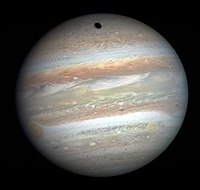
Photo from wikipedia
A spherical harmonic model of the magnetic field of Jupiter is obtained from vector magnetic field observations acquired by the Juno spacecraft during its first nine polar orbits about the… Click to show full abstract
A spherical harmonic model of the magnetic field of Jupiter is obtained from vector magnetic field observations acquired by the Juno spacecraft during its first nine polar orbits about the planet. Observations acquired during eight of these orbits provide the first truly global coverage of Jupiter’s magnetic field with a coarse longitudinal separation of ~45° between perijoves. The magnetic field is represented with a degree 20 spherical harmonic model for the planetary (“internal”) field, combined with a simple model of the magnetodisc for the field (“external”) due to distributed magnetospheric currents. Partial solution of the underdetermined inverse problem using generalized inverse techniques yields a model (“Juno Reference Model through Perijove 9”) of the planetary magnetic field with spherical harmonic coefficients well determined through degree and order 10, providing the first detailed view of a planetary dynamo beyond Earth. Plain Language Summary Characterizing the planetary magnetic field of Jupiter is one of the primary science objectives of the Juno Mission. The Juno spacecraft was launched on 5 August 2011 and was inserted into polar orbit about Jupiter on 4 July 2016. While only one fourth of the way through its baselinemission of 34 orbits, designed to characterize the planetarymagnetic field with resolution exceeding what is possible at Earth, a detailed representation of the field has emerged. The Jovian magnetic field is unlike anything previously imagined, evidencing a complexity that portends great insight into dynamo processes in general and the dynamics of Jupiter’s interior in particular.
Journal Title: Geophysical Research Letters
Year Published: 2018
Link to full text (if available)
Share on Social Media: Sign Up to like & get
recommendations!